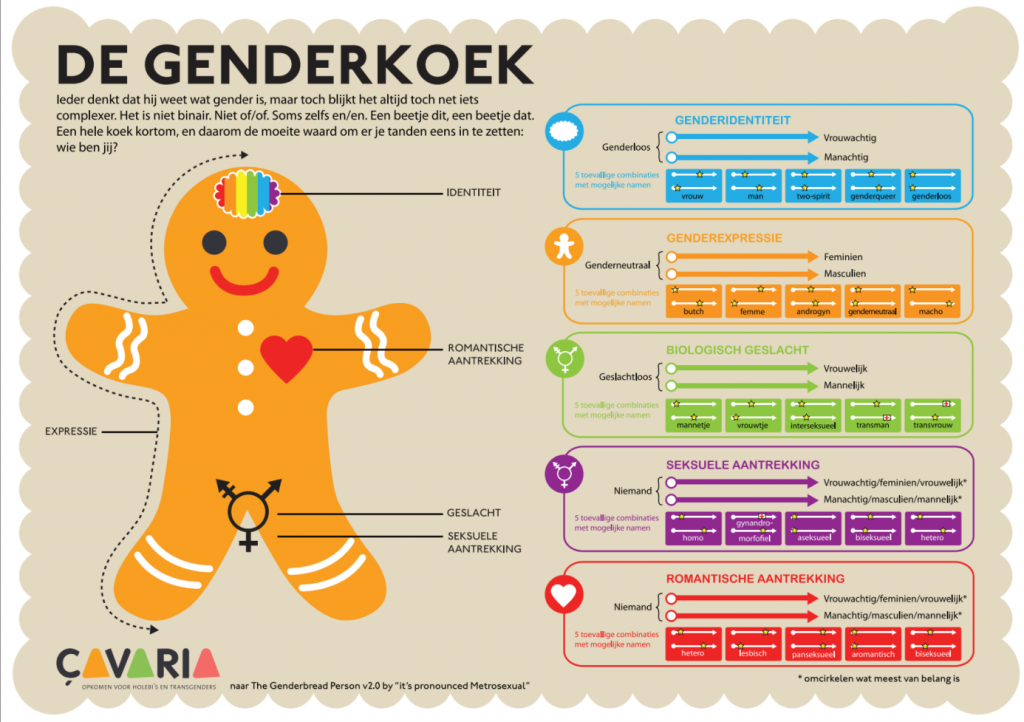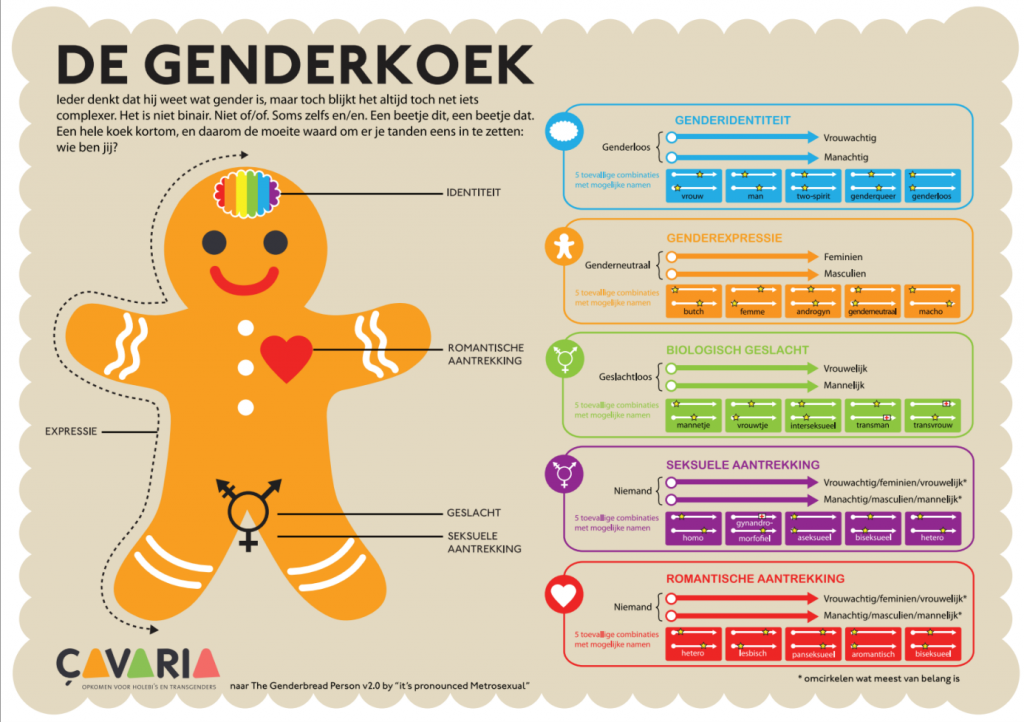Jan Bergstra & Laurens Buijs
Amsterdam Gender Theory Research Team
Structure of this blog
- Introduction
- What stands out about the Genderbread Person?
- Why does this matter?
- Gender versus sexual orientation
- Conclusion
1. Introduction
The Genderbread Person is the Dutch design of the Genderbread Person by Sam Killermann. This is a drawing of a puppet of gingerbread, now used in Dutch primary schools, for example, to educate children about gender and sexuality diversity.
On Google Scholar, we found no scientific publication by Sam Killermann: thus, his Genderbread Person is not scientifically based. Nor is this necessary for success; we refer only to the UvA sociologists who made a staff member on gender who was unwelcome to them in terms of their views leave without writing a single letter about gender theory themselves (see AGTRT-BF40).
Equally striking is Utrecht University’s research school on gender theory in the Netherlands: none of the work visible to us comes from there, but it still participates in the UvA mindset (see AGTRT-BF9, AGTRT-BF15 and AGTRT-BF25). This provides a simple description of woke: “woke” is being right without having to explain why and without doubting one’s own rightness. In that regard, there is still a lot of academic wokeness in Dutch.
Learn more about the basics of gender:
What is gender anyway, and why is biological sex not sufficient?
2. What stands out about the Genderbread Person?
We review the following Dutch version of the Genderbread Person which can be found on the Gender Point website:

What stands out there?
- That gender identity can take five forms we do not encounter in the serious literature on gender. That masculine and feminine are the qualifications measured or represented by gender identity is not clear to us.
- The notion of gender is missing and with it the concept of gender categorization. This immediately rendered incomprehensible what the discussion of gender and laws and regulations could be about. The Genderbread Person is not helpful in finding answers to the questions that are so topical right now, which are about who should be considered male and who should be considered female, who should be allowed to participate in sports and who gets access to women’s spaces, etc. We’ll just assume that the Genderbread Person takes the co-essentialist position with this: gender categorization runs exactly along the line of gender identity. But less clear is that and why, of the five types of gender, only three are candidates to be listed in a passport.
- In biological gender we encounter: male, female, transman, and transwoman. What would that mean? Is one sometimes biologically a male and “a female” at the same time? Are these diminutives meant to indicate that biological characteristics are less relevant? Is gender transition a matter of “biological sex” according to the Genderbread Person?
- Is sexual attraction a matter of gender expression or gender? In What is sexual orientation? (2016), Robin Dembroff identifies sexual attraction as something to be based primarily on gender, and thus not primarily on gender expression. Is Dembroff wrong? Or from what narrative of gender and sexual orientation can this aspect of the Genderbread Person be motivated differently?
- Two-spirit gender identity does not appear in the scientific literature on gender known to us. That may not matter much, but in biology or in mathematics, one would not want to work that way anyway.
- Gay is linked to sexual attraction, lesbian to romantic attraction, is that a manifestation of prejudice or is there theory behind this?
- Romantic attraction can be labeled bisexual. This is remarkable because it is precisely of romantic attraction that one might think it could be described in terms of gender. Or besides the principle that gender is separate from sexual orientation, do we also have the principle that gender is separate from romantic orientation?
3. Why does this matter?
These points matter, because time and again it appears that anyone who asks questions about something like the Genderbread Person is immediately placed in the corner of gender critical (quod non), and possibly even anti-gender (idem quod non).
In the article The Genderbread Person: mapping the social media debate about inclusive sexuality education (2023), Thalla van Wichelen, Emma Verhoeven and Priscilla Hau portray this problem nicely: criticism of the Genderbread Person there is portrayed as “anti-woke,” anti-inclusive, anti-gender ideology, anti-gender theory, anti-LHGBTI etc. On the idea that the Genderbread Person tells a story that lacks sufficient basis and for that reason would be open to criticism, these authors do not appear to be getting at it.
But the Genderbread Person is manifestly one-sided and does not provide sufficient guidance to understand the major social controversies at play here. And that’s not good, because to simply dismiss these controversies as enlightened versus backward is too short of the mark.
The GGenderbread Person is gender skeptical. And by this we mean that people are not interested in results of scientific work on gender. This is evidenced by the fact that useful and traceable connections to the scientific literature on this field are deliberately avoided.
We do not see the topic of gender as a license to fantasize about anything and everything but as a challenge to deal with it thoughtfully. The Genderbread Person would become a lot stronger if it brings a simpler narrative from which lines of debate and controversy can also be seen. That seems quite possible to us.
Read more about the difference between sex and gender:
The Dutch language is deficient for gender theory, and must be expanded to include male and female
4. Gender versus sexual orientation
The Genderbread Person too easily captures sexual orientation under the label gender. There is something against that, because these are two different things. Differences in sexual orientation that deviate from the heteronorm are still banned in many countries, and it was not so long ago that this was true in northwestern Europe.
This makes it immediately clear that these differences in sexual orientations exist, otherwise there would be no need to ban them anyway. Handling the diversity of sexual orientation well is of great importance, but by and large, here and elsewhere, it is a matter of ethics and morality. Not everyone agrees with that, of course, but that doesn’t change that anyway.
Gender identity involves a different issue. The rationale of the concept of transgender does not currently convince everyone, and that lack of obvious rationality of the concept of gender transition is certainly not simply a matter of ethics and morality. The issue of gender is of a different order than sexual orientation, surely the TERF ideologues (see AGTRT-BF43) should be allowed to get that much right.
To mention gender and sexual orientation in the same breath, as if they were of the same cloth, is not enlightening.
5. Conclusion
We come to the following conclusions about the Genderbread Person:
- The Genderbread Person is an influential intervention in education, but lacks connection to the scientific literature on gender.
- The Genderbread Person can be criticized on many issues, but those who offer such criticism are quickly dismissed in academic and intellectual circles as anti-woke, anti-inclusive and too gender critical.
- The Genderbread Person would become a lot stronger if it brings a simpler narrative underpinned by the literature on gender, and from which lines of debate and controversy can also be seen.
- The Genderbread Person would do well to clearly separate gender identity and sexual orientation as two distinct phenomena.

Leave a Reply